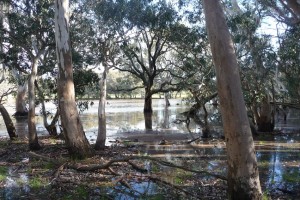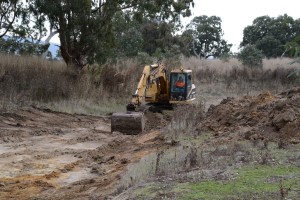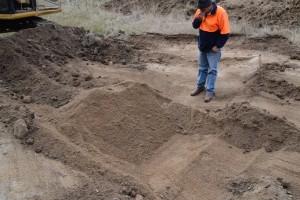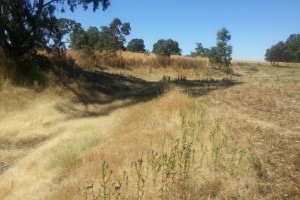This project was developed to aid the restoration of a five hectare swamp that occurs on a natural watercourse flowing into Fiery Creek. The site provides important water storage in the local drainage network whilst also supporting a high quality remnant red-gum forest that creates important habitat for local bird populations.
Earthworks undertaken by previous owners that included channel excavation and the construction of levee embankments have caused significant modification to the natural wetland area. Since purchasing the property the new owners had noticed changes occurring to the natural inundation zone of the swamp which had historically backed up into the standing red-gums. Concerned that the wetland area was impacted by these past works, the landholders were keen to engage with us to help find a possible solution and develop a remedial response to this issue. After preliminary assessments were undertaken we were able to identify that the recently excavated channels constructed by the previous owners had created a new subsurface drainage pathway for the surface water. The channel excavations had been cut through a shallow depth impervious clay layer in the natural soil structure, subsequently providing an exit route for the surface water to drain through a deeper deposited gravel bed, artificially hastening the loss of water from the wetland system.
On ground works were designed to reduce the depth of the excavated drainage channel by relining the channel bed to effectively reinstate the original confining clay layer. Suitable clay material was sourced on site and a local earthworks contractor was engaged to fill and re-line the drainage channels. To ensure that the capping material was suitably impervious, bentonite clay fines were integrated into the material to increase the sealing effectiveness of the bed material.
This Case Study is the third in a series to illustrate wetland restoration in practice, delivered through Nature Glenelg Trust’s Wetland Restoration Program on Private Land and funded by the Australian Government.
- Exciting news! – A major expansion of the Walker Swamp Restoration Reserve is happening this June 24/06/2024
In some incredibly exciting news, I am delighted to announce that Nature Glenelg Trust has just been awarded a $595,000 grant from the Victorian Government, through the Nature Fund Program.
This incredibly timely announcement is the final piece of a $1.19M funding ‘puzzle’ that has now been fully assembled. This funding is enabling NGT to expand ...
- Final update on NGT’s priorities before the end of June – See what a donation to NGT could support this year 24/06/2024
With the end of financial year just around the corner, if you have been thinking of providing a donation to NGT before tax time this year, please take a look at our main current priorities below.
The land purchase at Walker Swamp this June is a great example of the type of restoration project ...
- Reflecting on World Environment Day 2024 – and thinking ‘big’ in land restoration 24/06/2024
On the 5th of June, which marks World Environment Day each year, we received the fantastic news that NGT’s project to expand our reserve at Walker Swamp – to include a large woodland restoration component – was funded by the Victorian Government’s Nature Fund Program. The timing of the announcement seems especially fitting, given that ...
- The Community Nursery is overflowing – So we’re having a July sale! 24/06/2024
Our Community Nursery is overflowing with plants, and it’s driving our Nursery Coordinator Ange a little crazy. So we’ve decided to have a quick plant sale in July!
With the lack of rain we haven’t been able to plant out some of our project areas and there’s no room in the nursery to start next years ...
- Healing a critically endangered swamp – Hesperilla Conservation Park one year later 24/06/2024
Back in late March 2023, following a prescribed burn, NGT oversaw earthworks at Hesperilla Conservation Park, a reserve that protects an important remnant of the critically endangered Fleurieu Peninsula Swamp ecological community. The earthworks backfilled several drains that were drawing groundwater out of the swamp and dehydrating the upper level of the peat that underlies ...
- Natives are good in gardens too – NGT awarded grant to spread the word about native plants in Mt Gambier 24/06/2024
We are excited to announce that we have been awarded a grant to promote the use of indigenous plant species in public gardens around Mount Gambier! The project aims to encourage the community to include native plants in their own gardens, by creating demonstration native gardens around Mt Gambier to showcase our beautiful native species. ...
- Wannon River Insights Part 4 – Long-term study of freshwater fish of the upper Wannon River 24/06/2024
Over the past three years, as part of an investigation into the ecology and hydrology of the Wannon River, whose catchment begins in the Grampians National Park in Victoria, we’ve had the opportunity to really grow our understanding around freshwater fish distribution and movement in the upper Wannon. Our initial understandings stem from work which ...
- Benefits of camera monitoring – another exciting observation at Eaglehawk Waterhole! 24/06/2024
Camera Monitoring (capturing footage and images using fixed point cameras) can be a time-consuming, data-hungry technique, requiring many hours of review and verification; identifying the subject matter is not always easy either. However, as the following video shows, it can reveal some unexpected species sightings!
Andy Lines, our awesome volunteer at Eaglehawk Waterhole, has recently started ...
- Latest Orange-bellied Parrot Sightings, and new OBP website 24/06/2024
A few things have been happening in the world of the Orange-bellied Parrots (OBP) over the last couple of months.
Every year, three count weekends are held where volunteers survey for OBP throughout their range, from SA’s Murray Mouth to Gippsland in Victoria, at the same time. The May count weekend recorded no sightings of OBP ...
- That’s a wrap – Annual Mount Lofty Ranges fish monitoring complete 24/06/2024
The annual Mount Lofty Ranges fish and habitat monitoring has been completed by NGT staff, revealing great ongoing data and trends in native and alien fish populations throughout the region. Monitoring in 2024 represents more than twenty years of data which is an amazing accomplishment. The work, funded by the Hills and Fleurieu, Murraylands and ...
Click here for the full list of project related blogs






Sorry, the comment form is closed at this time.